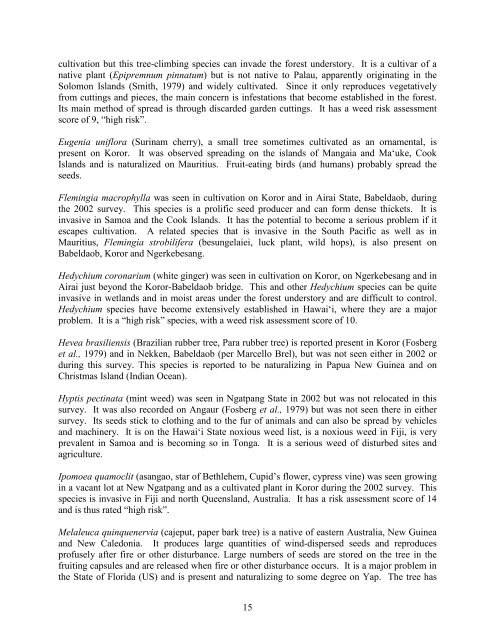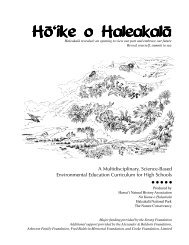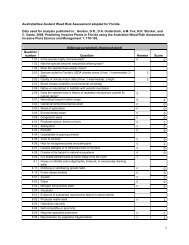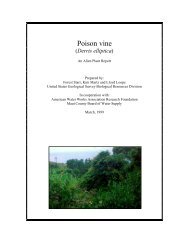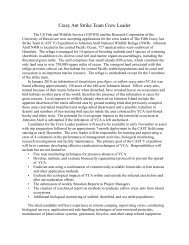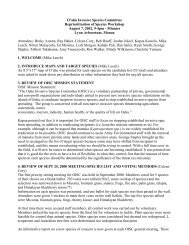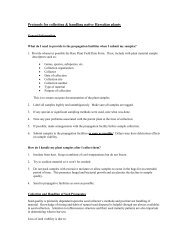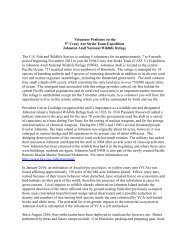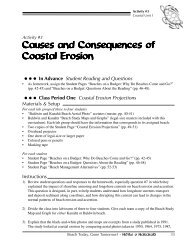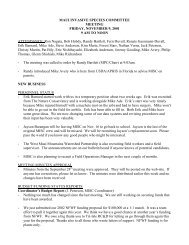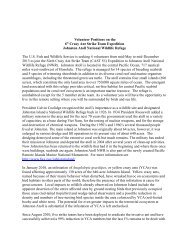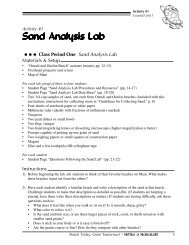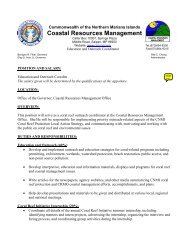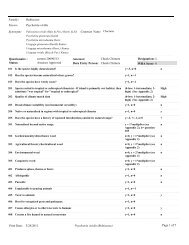Report to the Republic of Palau: 2008 update on Invasive Plant ...
Report to the Republic of Palau: 2008 update on Invasive Plant ...
Report to the Republic of Palau: 2008 update on Invasive Plant ...
You also want an ePaper? Increase the reach of your titles
YUMPU automatically turns print PDFs into web optimized ePapers that Google loves.
cultivati<strong>on</strong> but this tree-climbing species can invade <str<strong>on</strong>g>the</str<strong>on</strong>g> forest unders<str<strong>on</strong>g>to</str<strong>on</strong>g>ry. It is a cultivar <str<strong>on</strong>g>of</str<strong>on</strong>g> a<br />
native plant (Epipremnum pinnatum) but is not native <str<strong>on</strong>g>to</str<strong>on</strong>g> <str<strong>on</strong>g>Palau</str<strong>on</strong>g>, apparently originating in <str<strong>on</strong>g>the</str<strong>on</strong>g><br />
Solom<strong>on</strong> Islands (Smith, 1979) and widely cultivated. Since it <strong>on</strong>ly reproduces vegetatively<br />
from cuttings and pieces, <str<strong>on</strong>g>the</str<strong>on</strong>g> main c<strong>on</strong>cern is infestati<strong>on</strong>s that become established in <str<strong>on</strong>g>the</str<strong>on</strong>g> forest.<br />
Its main method <str<strong>on</strong>g>of</str<strong>on</strong>g> spread is through discarded garden cuttings. It has a weed risk assessment<br />
score <str<strong>on</strong>g>of</str<strong>on</strong>g> 9, “high risk”.<br />
Eugenia uniflora (Surinam cherry), a small tree sometimes cultivated as an ornamental, is<br />
present <strong>on</strong> Koror. It was observed spreading <strong>on</strong> <str<strong>on</strong>g>the</str<strong>on</strong>g> islands <str<strong>on</strong>g>of</str<strong>on</strong>g> Mangaia and Ma‘uke, Cook<br />
Islands and is naturalized <strong>on</strong> Mauritius. Fruit-eating birds (and humans) probably spread <str<strong>on</strong>g>the</str<strong>on</strong>g><br />
seeds.<br />
Flemingia macrophylla was seen in cultivati<strong>on</strong> <strong>on</strong> Koror and in Airai State, Babeldaob, during<br />
<str<strong>on</strong>g>the</str<strong>on</strong>g> 2002 survey. This species is a prolific seed producer and can form dense thickets. It is<br />
invasive in Samoa and <str<strong>on</strong>g>the</str<strong>on</strong>g> Cook Islands. It has <str<strong>on</strong>g>the</str<strong>on</strong>g> potential <str<strong>on</strong>g>to</str<strong>on</strong>g> become a serious problem if it<br />
escapes cultivati<strong>on</strong>. A related species that is invasive in <str<strong>on</strong>g>the</str<strong>on</strong>g> South Pacific as well as in<br />
Mauritius, Flemingia strobilifera (besungelaiei, luck plant, wild hops), is also present <strong>on</strong><br />
Babeldaob, Koror and Ngerkebesang.<br />
Hedychium cor<strong>on</strong>arium (white ginger) was seen in cultivati<strong>on</strong> <strong>on</strong> Koror, <strong>on</strong> Ngerkebesang and in<br />
Airai just bey<strong>on</strong>d <str<strong>on</strong>g>the</str<strong>on</strong>g> Koror-Babeldaob bridge. This and o<str<strong>on</strong>g>the</str<strong>on</strong>g>r Hedychium species can be quite<br />
invasive in wetlands and in moist areas under <str<strong>on</strong>g>the</str<strong>on</strong>g> forest unders<str<strong>on</strong>g>to</str<strong>on</strong>g>ry and are difficult <str<strong>on</strong>g>to</str<strong>on</strong>g> c<strong>on</strong>trol.<br />
Hedychium species have become extensively established in Hawai‘i, where <str<strong>on</strong>g>the</str<strong>on</strong>g>y are a major<br />
problem. It is a “high risk” species, with a weed risk assessment score <str<strong>on</strong>g>of</str<strong>on</strong>g> 10.<br />
Hevea brasiliensis (Brazilian rubber tree, Para rubber tree) is reported present in Koror (Fosberg<br />
et al., 1979) and in Nekken, Babeldaob (per Marcello Brel), but was not seen ei<str<strong>on</strong>g>the</str<strong>on</strong>g>r in 2002 or<br />
during this survey. This species is reported <str<strong>on</strong>g>to</str<strong>on</strong>g> be naturalizing in Papua New Guinea and <strong>on</strong><br />
Christmas Island (Indian Ocean).<br />
Hyptis pectinata (mint weed) was seen in Ngatpang State in 2002 but was not relocated in this<br />
survey. It was also recorded <strong>on</strong> Angaur (Fosberg et al., 1979) but was not seen <str<strong>on</strong>g>the</str<strong>on</strong>g>re in ei<str<strong>on</strong>g>the</str<strong>on</strong>g>r<br />
survey. Its seeds stick <str<strong>on</strong>g>to</str<strong>on</strong>g> clothing and <str<strong>on</strong>g>to</str<strong>on</strong>g> <str<strong>on</strong>g>the</str<strong>on</strong>g> fur <str<strong>on</strong>g>of</str<strong>on</strong>g> animals and can also be spread by vehicles<br />
and machinery. It is <strong>on</strong> <str<strong>on</strong>g>the</str<strong>on</strong>g> Hawai‘i State noxious weed list, is a noxious weed in Fiji, is very<br />
prevalent in Samoa and is becoming so in T<strong>on</strong>ga. It is a serious weed <str<strong>on</strong>g>of</str<strong>on</strong>g> disturbed sites and<br />
agriculture.<br />
Ipomoea quamoclit (asangao, star <str<strong>on</strong>g>of</str<strong>on</strong>g> Bethlehem, Cupid’s flower, cypress vine) was seen growing<br />
in a vacant lot at New Ngatpang and as a cultivated plant in Koror during <str<strong>on</strong>g>the</str<strong>on</strong>g> 2002 survey. This<br />
species is invasive in Fiji and north Queensland, Australia. It has a risk assessment score <str<strong>on</strong>g>of</str<strong>on</strong>g> 14<br />
and is thus rated “high risk”.<br />
Melaleuca quinquenervia (cajeput, paper bark tree) is a native <str<strong>on</strong>g>of</str<strong>on</strong>g> eastern Australia, New Guinea<br />
and New Caled<strong>on</strong>ia. It produces large quantities <str<strong>on</strong>g>of</str<strong>on</strong>g> wind-dispersed seeds and reproduces<br />
pr<str<strong>on</strong>g>of</str<strong>on</strong>g>usely after fire or o<str<strong>on</strong>g>the</str<strong>on</strong>g>r disturbance. Large numbers <str<strong>on</strong>g>of</str<strong>on</strong>g> seeds are s<str<strong>on</strong>g>to</str<strong>on</strong>g>red <strong>on</strong> <str<strong>on</strong>g>the</str<strong>on</strong>g> tree in <str<strong>on</strong>g>the</str<strong>on</strong>g><br />
fruiting capsules and are released when fire or o<str<strong>on</strong>g>the</str<strong>on</strong>g>r disturbance occurs. It is a major problem in<br />
<str<strong>on</strong>g>the</str<strong>on</strong>g> State <str<strong>on</strong>g>of</str<strong>on</strong>g> Florida (US) and is present and naturalizing <str<strong>on</strong>g>to</str<strong>on</strong>g> some degree <strong>on</strong> Yap. The tree has<br />
15


